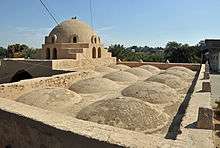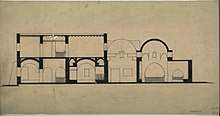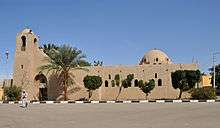Hassan Fathy
Hassan Fathy (March 23, 1900 – November 30, 1989, Egyptian Arabic: حسن فتحي) was a noted Egyptian architect who pioneered appropriate technology for building in Egypt, especially by working to reestablish the use of adobe and traditional mud construction as opposed to western building designs, material configurations, and lay-outs. Fathy was recognized with the Aga Khan Chairman's Award for Architecture in 1980. In 2017, Google celebrated Fathy with a Google Doodle for "pioneering new methods [in architecture], respecting tradition [Egyptian heritage and tradition], and valuing all walks of life".[2]
Hassan Fathy | |
|---|---|
.jpg) Hassan Fathy on the right | |
| Born | حسن فتحي March 23, 1900 |
| Died | November 30, 1989 (aged 89) |
| Nationality | Egyptian |
| Occupation | Architect |
| Awards |
|
Career

Hassan Fathy was a cosmopolitan trilingual professor-engineer-architect, amateur musician, dramatist, and inventor. He designed nearly 160 separate projects, from modest country retreats to fully planned communities with police, fire, and medical services, markets, schools, theatres, and places for worship and recreation. These communities included many functional buildings such as laundry facilities, ovens, and wells. He utilized ancient design methods and materials, as well as knowledge of the rural Egyptian economic situation with a wide knowledge of ancient architectural and town design techniques. He trained local inhabitants to make their own materials and build their own buildings.
Early career / New Gourna
He began teaching at the College of Fine Arts in 1930 and designed his first adobe buildings in the late 1930s.
Fathy gained international critical acclaim for his involvement in the construction of New Gourna, located on Luxor's West Bank, built to resettle the village of Gourna, which fell within the archaeological areas of the Valley of the Kings and the Valley of the Queens.[3]

Fathy's plan devised groundbreaking approaches to economic, social, and aesthetic issues that typically impact the construction of low-cost housing.
With regard to the economic issues, Fathy noted that structural steel was not an apt choice for a poor country, and that even materials such as cement, timber, and glass did not make good economic sense. To address this issue, Fathy instead devised a plan that included the use of appropriate technology, notably mud brick construction.
Noting that the traditional village, although afflicted with issues of overcrowding and poor sanitation was also an expression of “a living society in all its complexity,” Fathy strived to design New Gourna in a manner that addressed the social concerns, including attempting to consult directly with "every family in Gourna" and advocating for the involvement of social ethnographers in the planning process[4]. Despite this, inhabitants of the former village were not enthusiastic about relocating, which effectively cut them off from their existing livelihood of trading in archaeological finds[5].
With regard to aesthetic issues, Fathy placed emphasis on traditional Nubian architectural designs which he observed in a 1941 trip to the region (enclosed courtyards; vaulted roofing), yielding what Fathy described as "spacious, lovely, clean, and harmonious houses." He also made use of traditional Nubian ornamental techniques (claustra, a form of mud latticework), as well as vernacular architecture techniques of the Gourna region. Some critics have observed, however, that Fathy's project for Gourna is not a superlative example of hw to prioritize vernacular architecture in an urban plan, given that the domed architecture Fathy championed is traditionally used for funerary architecture rather than residential or domestic spaces[6]
Later career
In 1953 he returned to Cairo, heading the Architectural Section of the Faculty of Fine Arts in 1954.[7]
Fathy's next major engagement was designing and supervising school construction for Egypt's Ministry of Education.
In 1957, frustrated with bureaucracy and convinced that buildings designed with traditional methods appropriate to the climate of the area would speak louder than words,[8] he moved to Athens to collaborate with international planners evolving the principles of ekistical design under the direction of Constantinos Apostolou Doxiadis. He served as the advocate of traditional natural-energy solutions in major community projects for Iraq and Pakistan and undertook extended travel and research for the "Cities of the Future" program in Africa.
Returning to Cairo in 1963, he moved to Darb al-Labbana, near the Cairo Citadel, where he lived and worked for the rest of his life. He also did public speaking and private consulting. He was a man with a riveting message in an era searching for alternatives in fuel, personal interactions, and economic supports.
He left his first major international position, at the American Association for the Advancement of Science in Boston, in 1969 to complete multiple trips per year as a leading critical member of the architectural profession.
His participation in the first U.N. Habitat conference in 1976 in Vancouver which was followed shortly by two events that significantly shaped the rest of his activities. He began to serve on the steering committee for the nascent Aga Khan Award for Architecture and he founded and set guiding principles for his Institute of Appropriate Technology.
He was part in 1979 of a colloquium entitled in his honour 'Architecture for the Poor' in Corsica (France) Alzipratu.[9]
In 1980, he was awarded the Balzan Prize for Architecture and Urban Planning and the Right Livelihood Award.
Fathy designed the mosque and madrasa, constructed with adobe, at Dar al-Islam, an educational center near Abiquiú, New Mexico, USA.[10][11][12][13] The main buildings were completed in 1981,[11] and Dar al-Islam opened in 1982.[12]
He held several government positions and died in Cairo in 1989.
Legacy
Fathy has been called Egypt's best-known architect since Imhotep.
Fathy's New Gourna project was applauded in a popular British weekly in 1947 and soon after in a British professional journal[14]; further articles were published in Spanish, French and in Dutch. Later, Fathy would author a book on the New Gourna project, initially published by Cairo's Ministry of Culture in a limited edition in 1969, entitled Gourna: A Tale of Two Villages. In 1973 it was republished by the University of Chicago as Architecture for the Poor: An Experiment in Rural Egypt.[15]
A full appreciation of the importance of Fathy's contribution to world architecture became clear only as the twentieth century waned. Climatic conditions, public health considerations, and ancient craft skills also affected his design decisions. Based on the structural massing of ancient buildings, Fathy incorporated dense brick walls and traditional courtyard forms to provide passive cooling.[16] Fathy is also renowned for having revived the traditional Nubian vault.[17]
National Life Stories conducted an oral history interview (C467/37) with Hassan Fathy in 1986 for its Architects Lives' collection held by the British Library.[18]
Hassan Fathy made use of windcatchers and other passive cooling and passive ventilation methods from traditional architecture. He wrote a book on them.[19]
Personal life
Hassan Fathy was born in Alexandria in 1900, to an Egyptian father and Turkish mom.[20]
He trained as an architect in Egypt, graduating in 1926 from the King Fuad University (now Cairo University).[21] Fathy married once, to Aziza Hassanein, sister of Ahmed Hassanein. He designed a villa for her along the Nile in Maadi, which was destroyed to make way for the corniche. He also designed her brother's mausoleum (1947), along Salah Salem, in Neo-Mamluk style.
The children of his five brothers and sisters, aware of the obligation to preserve the heritage of their uncle, tried to make sure that the materials transmitting his ideals and his art will remain available in Egypt for the future benefit of that country.
References
- 1980 Balzan Prize for Architecture and Urban Planning https://www.balzan.org/en/prizewinners/hassan-fathy
- "Hassan Fathy: Why is Google inspired by his works?". www.aljazeera.com. Retrieved 2017-03-23.
- "Arts In Egypt". Retrieved 10 May 2012.
- Fathy, Hassan (1973). Architecture for the Poor: An Experiment in Rural Egypt. University of Chicago.
- Bertini, Viola. "Hassan Fathy (1900-1989)". The Architectural Review. Retrieved July 15, 2020.
- "Hassan Fathy and The Architecture for the Poor: The Controversy of Success". Archidatum. Retrieved July 15, 2020.
- Goldschmidt 1999, p. 56.
- Fathy 1986.
- "Hassan Fathy en Corse" [Hassan Fathy in Corsica]. Le Monde (in French). 21 June 1979.
- Fathy 2008.
- Stegers 2008, p. 210.
- Curtis 2010, p. 134.
- Schleifer 1984.
- Hassan Fathy; all projects: https://www.bibalex.org/Attachments/Publications/Files/hassan_fathy.pdf&ved=2ahUKEwidyJDss5XpAhXJzaQKHT_aAZIQFjABegQIBhAB&usg=AOvVaw3EfYY6dVeBls9uQoVKpPAH
- Fathy 1976.
- Roth 1993, p. 118.
- collective, dir. Serge Santelli (2011–2012). Hassan Fathy, An Egyptian Ambition. Gezira Art Center.
- Courtney, Cathy, interviewer (1986). Fathy, Hassan (1 of 4) National Life Story Collection: Architects' Lives (audio recording). Cairo, Egypt: The British Library Board. Retrieved 2019-10-31.
- Fathy, Hassan. Natural Energy and Vernacular Architecture. (free fulltext)
- El-Rashidi, Yasmine (2000), Remembering 'the Master', Al-Ahram, retrieved 16 September 2017,
1900 Born in Alexandria to an Upper Egyptian father and Turkish mother
- Hassan Fathy - Biliotheca Alexandrina
Bibliography
- Fathy, Hassan (1976) [1973]. Architecture for the Poor : An Experiment in Rural Egypt. Chicago: University of Chicago Press. ISBN 9780226239163. OCLC 1020172729.CS1 maint: ref=harv (link)
- Fathy, Hassan (1986). Shearer, Walter (ed.). Natural Energy and Vernacular Architecture : Principles and Examples, With Reference to Hot Arid Climates. University of Chicago Press. ISBN 9780226239170. OCLC 1036744049.CS1 maint: ref=harv (link)
- Abdel-moniem El-Shorbagy, Hassan Fathy: The Power of Belief. Lambert Academic Publishing, Germany, 2017.
- Abdel-moniem El-Shorbagy, Hassan Fathy: The Language of Traditional Architecture. Lambert Academic Publishing, Germany, 2017.
Sources
- Curtis, Edward (2010). "Dar al-Islam community (New Mexico)". Encyclopedia of Muslim-American history. New York: Facts on File. p. 134. ISBN 9781438130408. OCLC 650849872.CS1 maint: ref=harv (link)
- Fathy, Hassan (2008-11-21). "Dar al Islam Abiquiu Program Site". MIT Libraries. Retrieved 2019-10-23.CS1 maint: ref=harv (link)
- Goldschmidt, Arthur (1999). Biographical dictionary of modern Egypt. Boulder, CO: L. Rienner. p. 56. ISBN 9781588269850. OCLC 841810840.CS1 maint: ref=harv (link)
- Nobbs-Thiessen, Max (2008) [2006]. Contested representations and the building of modern Egypt : the architecture of Hassan Fathy (MA). Ottawa: Library and Archives Canada = Bibliothèque et Archives Canada. ISBN 9780494294062. OCLC 471036139.
- Roth, Leland (1993). Understanding architecture : its elements, history, and meaning. New York, NY: Icon Editions. ISBN 9780064301589. OCLC 643834100.CS1 maint: ref=harv (link)
- Schleifer, S. Abdullah (1984). "Hassan Fathy's Abiquiu: An Experimental Islamic Educational Center in Rural New Mexico". Ekistics. 51 (304): 56–60. ISSN 0013-2942. JSTOR 43620415. OCLC 5987894730.CS1 maint: ref=harv (link)
- Steele, James (1997). An architecture for people : the complete works of Hassan Fathy. New York: Whitney Library of Design. ISBN 9780823002269. OCLC 9159872006.
- Stegers, Rudolf (2008). "Dar Al Islam Mosque". Sacred buildings : a design manual. Basel; Boston: Birkhäuser. pp. 210–211. doi:10.1007/978-3-7643-8276-6_63. ISBN 9783764382766.CS1 maint: ref=harv (link)
External links
| Wikimedia Commons has media related to Hassan Fathy. |
- Fathy, Hassan. "The wind factor in air movement". Natural Energy and Vernacular Architecture. (free fulltext)
- Digital collection of Hassan Fathy's architectural drawings
- Fathy's the Father of Sustainable Architecture in the Middle East
- Biography and images of Fathy's architecture
- Picture gallery from Hassan Fathy's project "New Baris" in Kharga Oasis, Egypt at Remains.se
- "A Hassan Fathy Quotation". solarhousehistory.com.
